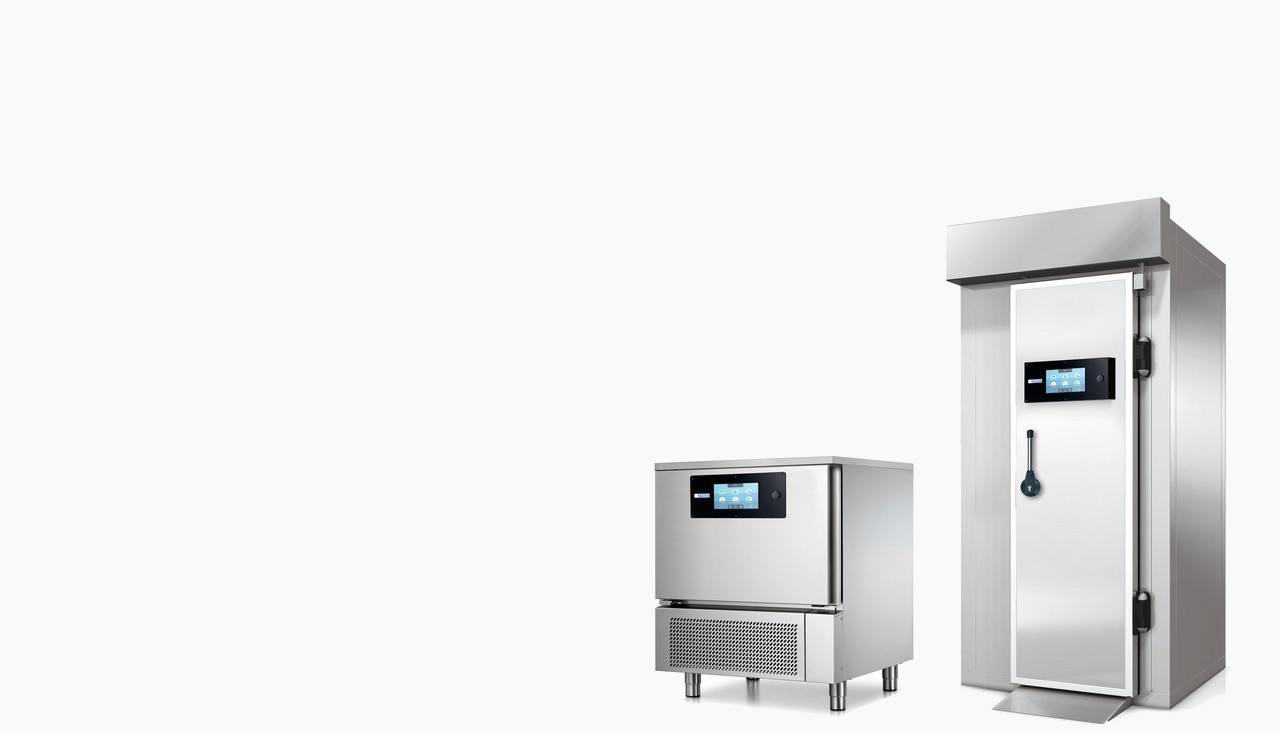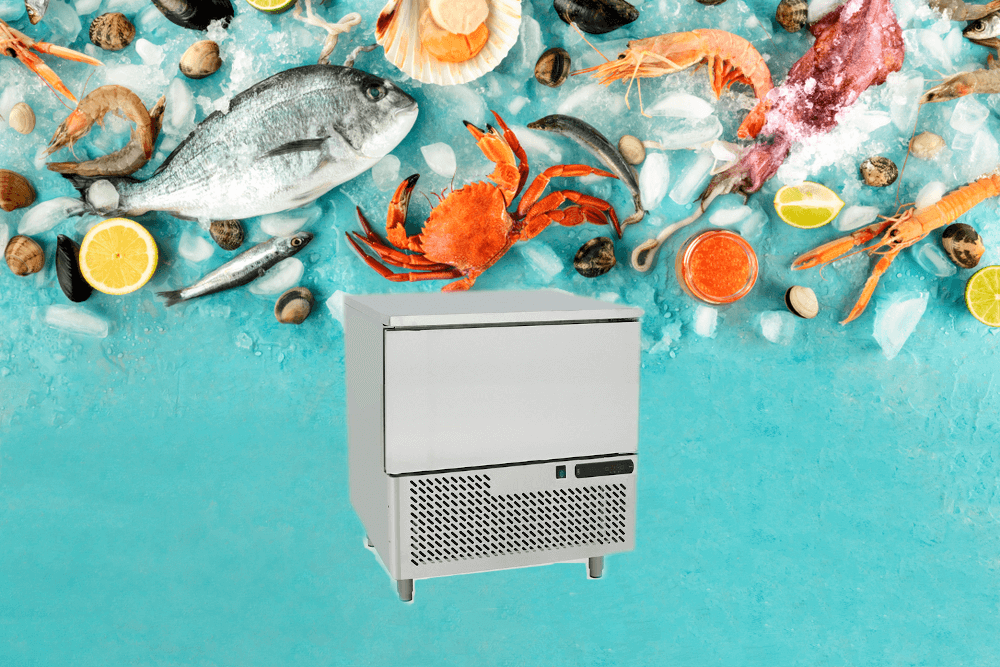Blast freezers and chillers are very important for both food safety reasons and for keeping customers happy. But how do blast freezers work, and what is blast freezing?
That’s what this guide is all about. So let’s jump in:
Table of contents:
- What is a blast freezer and chiller?
- The blast freezing process
- Blast freezer specifications & equipment
- Blast freezer applications
What is a blast freezer and chiller?
Put very simply, a blast freezer is just a freezer that stores food at very, very cold temperatures.
Blast freezers are designed to rapidly freeze whatever is put in them. Usually, this involves food. It is important to bring the temperature down on food very quickly, to kill off and prevent bacteria from multiplying in the food.
Because of this, blast freezers are widely used across the food industry, and especially in processing, but also in many commercial kitchens.
Blast freezers are often called upon to quickly freeze:
- Fresh vegetables
- Fish and raw meat
- Pre-prepared ready meals
- Delicate food (such as pasta, fruit extracts & soufflés)
- Vaccines and other medical technologies
- Chemicals
To name just a few examples.
How does a blast chiller work?
People often refer to ‘blast chillers’ and ‘blast freezers’ like they are the same thing. They’re not. As the name suggests, a blast chiller is more like a juiced-up fridge and the other is like a juiced-up freezer.
A blast chiller cools food very quickly by rapidly blowing cold air over it. The food is then usually removed from the blast chiller and stored in a regular freezer.
Unlike blast freezers, blast chillers are not essential for food safety reasons. But there are many benefits to having one. For example, they can improve the quality of the food by locking in nutrients and taste, and they can help cut back on food waste.
There are two forms of blast chilling:
- Soft chilling — In most blast chillers available, the ‘soft’ option provides an air temperature between 3 degrees Celsius and -2 degrees Celsius in order to lower the temperature sufficiently in the actual chiller’s cabinet. The chiller is able to reduce the temperature of food and ingredients gently but quickly without causing any damage by using the high powered ventilation system.
This particular chilling method is best used with small, thin, delicate or unpacked products including dairy such as quiches, flans and custard tarts; lightly fried food; rice and vegetables.
- Hard chilling — In most blast chillers available, the hard option produces an air temperature of approximately as low as -20 degrees Celsius. With this temperature, the cabinet can quickly and safely fall to 3 degrees Celsius in order for the core temperature of food to pass through what is known as the danger zone as fast as possible.
This particular chilling method is best used with packaged or large, fatty or dense food products and ingredients. It is recommended that a core probe is always used to monitor and measure food at the chiller’s core temperature.
The blast freezer’s working principle
In order to use a blast freezer correctly and safely, according to the legal rules put in place by the HACCP (Hazard Analysis and Critical Control Points) and Government Food Standards Agency standards, the temperature of the food being frozen must drop from +70°C to -18°C in 240 minutes or less. In other words, it should be frozen as quickly as possible.
This is very important. Because when food is anywhere between +68°C and +8ºC it is classed as being in the danger zone. Between these temperatures, bacteria can get into the food and multiply really fast. So it’s crucial to get the temperature down as quickly as possible — to keep the food safe.
You can only do this confidently with a blast freezer. A regular freezer might not be fast enough.
Did you know?
A typical blast freezer temperature hangs between -30 to -40°C. This is far colder than regular freezers, which tend to keep food at around 0°C.
The big temperature difference means a blast freezer can freeze food effectively in under 3 hours. Where it might take anywhere from 6-12 hours in a normal freezer.
The blast freezing process
Blast freezing is the process of pushing very cold air over a food product in order to freeze it as quickly as possible. There are different types of blast freezers in which the blast freezing process is a little different. Such as:
- Single-load blast freezers — that freeze batches of products at a time.
- Continuous blast freezers — such as tunnel freezers that continually wash cold air over the products as they move through the blast freezer on a conveyor belt..
There are different types of blast freezers that focus on different sections of the frozen food market. Some specialise in preserving cakes and baked goods. While others are better for seafood and meat products. Blast freezers are also found in some industrial settings, such as in the chemicals and oil and gas sectors.
What is the blast freezing process and how does a blast freezer work?
Blast freezing is a way to quickly keep food safe from bacteria and also to preserve the taste and nutritional value of the food. Only by freezing food rapidly can both of these things be achieved.
Blast freezing works by freezing food so quickly that the water molecules inside don’t have a chance to damage the food itself.
When water freezes at or just below 0°C it tends to freeze in a lattice-type pattern. This pattern then forms into pure ice crystals in the cells that make up the food. This lattice formation effectively “pushes out” everything else inside of the individual food cells, as well as having the effect of concentrating cell-damaging enzymes and electrolytes — which can then damage the cell walls.
The slower the freezing process, the more time the water has a chance to develop this damaging lattice formation.
But if you freeze food rapidly — which is how a blast freezer functions — the water freezes before it gets the chance to organize into this lattice shape. The result is that much smaller ice crystals form, leaving behind more space for the electrolytes and enzymes within the cell. This stops them from coming into contact with and bursting the cell membranes and walls. Causing less damage.
This is how to blast freeze food. The result is that when it is eventually thawed, there are fewer damaged cells in the food. And in seafood and meat, this can mean firmer flesh that more closely resembles how the food would have looked back when it was fresh.
Food quality: Blast freezers versus normal freezers
In most cases, normal freezers are not adequate enough to preserve the quality of food that is needed for the restaurant or food processing industries. If a slow frozen product is thawed, the damaged cells inside dissolve into the surrounding flesh of the food and drain away. The result is that the food becomes soft, wilted and mushy — and loses all of its firmness and integrity.
So if you’re serious about protecting food, there is no competition. Regular freezers do not stand up to blast freezing technology.

A word on shock freezers and flash freezers
Blast freezers go by many names. Two common terms are ‘shock freezers’ and ‘flash freezers’.
It is not uncommon for people to ask us which is better — a blast freezer versus a flash freezer. The answer is: they’re both the same thing!
Blast freezer specifications & equipment
There are lots of different types of blast freezers. They are all manufactured to meet the service needs of different companies all within the food processing and general food industries. Some of the most common types include:
- Standard type blast freezers
- Tray-ins
- Cart-in types
- Rack types
- Spiral blast freezers
- Straight model (tunnel) types
- Duo (two freezers attached) types
Most modern models now feature movable trays that allow you to customise the positioning of food stored inside to optimise freezing times.
If you are thinking of getting a blast freezer but aren’t sure which one is the best for your business — we can help. Just visit our contact us page. There our specialists will be more than happy to run through all of the different designs and specifications along with you.
Ask us about blast freezers — we’ll respond ASAP
Blast freezer prices
Blast freezer prices vary by size, the inlet and outlet temperature required, the hours required of operation and more. So it wouldn’t make much sense to give an overall price — as it can vary by quite a lot.
Blast freezers are a necessary requirement in some food processing and restaurant businesses. If you are looking for a blast freezer or blast chiller, then please get in touch. One of our specialists will be happy to talk with you about the type you’re likely to need, and we’ll give you a FREE custom price quotation.
Advantages of blast freezing
- Blast freezing locks in the nutritional value, flavour, texture and colour of the food it preserves.
- Food involving delicate preparations such as pasta, soufflés and fruit extracts are protected from damage due to the rapid freezing process.
- Blast freezing is very safe and stops bacteria and other microorganisms from growing inside the food.
- Food from a blast freezer when thawed keeps its structure and quality better.
- Food cross-contamination is very low with a blast freezer as it provides different compartments for different food preservation.
- Blast freezers are ideal for storing very large batches of leftovers, meaning that a chef’s options are increased, while his food wastage is decreased.
Disadvantages of blast freezing
In an ideal world, everyone would have a blast freezer. They protect against germs, keep the nutrients locked in food and keep food tasting better.
So why doesn’t everyone have a blast freezer?
The answer is they consume a lot of energy, and so are too expensive for the average household to run. In an industry setting, they work brilliantly. But unfortunately, they are only suitable for commercial use at this time.
It is also important to be careful when using blast freezers not to store too high a volume of hot food as this will increase the overall internal temperature. There is always a large amount of space between the trays in a blast freezer as cold air is pumped in to counteract this — but still, use caution.

Blast freezer applications
Blast freezers are used across many industries. Not just in food processing, restaurants and other food-related ones. Including:
- Transport — distributors and caterers often need to ship items that are frozen in blast freezers.
- Pharmaceuticals — vaccines, blood plasma, biologics, and other vital materials often have to be kept inside blast freezers.
- Cross-industry applications — most blast freezers have different compartments within them so that multiple different items can be stored without having to worry about cross-contamination.
If you’re looking for a blast freezer or blast chiller to buy — or if your model has broken down or is in need of some maintenance — we can help.
We’ve helped thousands of businesses in the London and southwest area of the UK to get their blast freezers up and running. And we’re always ready to fix them when things go wrong.
If you’re unsure about the type of blast freezer you need, we’ll come out to your commercial property and conduct a FREE no-obligation site survey at a time of your convenience.
Check out our blast freezers main service page for more information.






